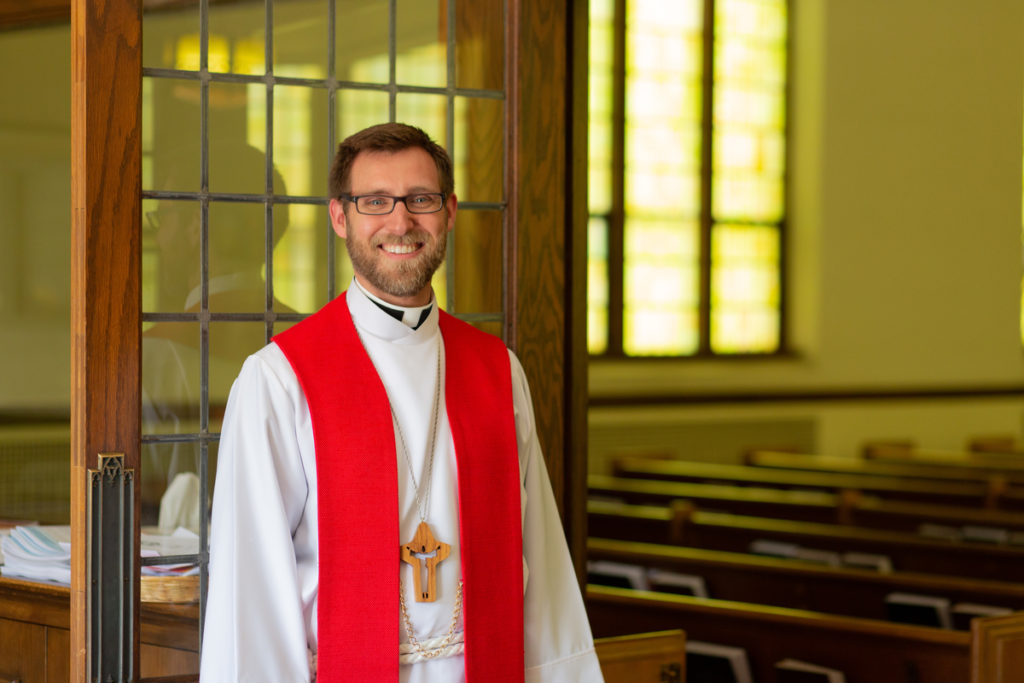Editor’s Note: In this article, author David Charlton thoughtfully critiques Reconciling Scripture for Lutherans, a commentary on Scripture. It was written by Reconciling Works which advocates “for the full welcome, inclusion, and equity of lesbian, gay, bisexual, transgender, queer, intersex and asexual/aromantic (LGBTQIA+) Lutherans in all aspects of the life of their Church, congregations, and community.” While independent, Reconciling Works is closely affiliated with the ELCA.
Reconciling Scripture for Lutherans begins by listing four “common metrics for scriptural interpretation” taken from the writings of Martin Luther. The list includes: a) the Law/Gospel Dialectic, b) the Plain Reading of Scripture, c) Scripture Interprets Scripture, and d) Scripture as the Manger that Holds Christ.[1] These are indeed common Lutheran principles for interpreting Scripture. One principle that I would expect to find, but did not, is was Christum treibt, or “whatever teaches Christ.” However, I have no objection to the four mentioned.
In general, the description of each is sound. However, I do have a question regarding the Plain Reading metric. It seems anachronistic to include the modern historical critical method as part of that principle. That method would not be developed and standardized for several centuries after Luther’s time. It is more likely that Luther had in mind what some call the historical grammatical method. Luther used the best in contemporary textual criticism, Greek and Hebrew lexicons, and knowledge of history. What would Luther know about source, form, redaction, or narrative criticism? What would he know of the several quests for the historical Jesus?
The real difficulty with these “common metrics” are how they are applied in interpreting two kinds of texts, labeled “Passages Used to Exclude” and “Passages Used to Welcome.” I will address each section separately, giving examples of how all four metrics are applied to both kinds of passages.
Passages Used to Exclude
There are eight Biblical texts described as “passages used to exclude.” The intent is to demonstrate how the four Lutheran metrics clear up confusion about the meaning of these texts. The question for us is whether the Lutheran metrics are applied correctly, and whether they succeed in the purpose for which they are used.
The Law/Gospel principle is used to address Genesis 1:26-29 and Romans 1:22-27. In the three pages dedicated to Genesis 1:26-29, there is only one reference to Law, and one to Gospel. The authors make the dubious claim that the phrase “male and female he created them” cannot be taken as Law because it is not grammatically in the form of a command.[2] They certainly know better than that. Lutherans have never limited Law to grammatical commands. The Law is understood more broadly than that. While including grammatical commands, it also includes anything that is taken as normative, makes demands, accuses or condemns. The authors undermine this argument three paragraphs later when they refer to “the Gospel in this passage.”[3] They do not cite a grammatical promise that serves as Gospel. Instead, they infer a Gospel promise from the descriptive passage in verse 27, which says that humankind was created in the image of God. If Gospel can be inferred, then so can Law. On the other hand, if absent a grammatical command, no Law can be inferred, then absent a grammatical promise, no Gospel can be inferred.
The discussion of Romans 1:22-27 also fails to apply the Law/Gospel principle correctly. However, it does so in a different way. It misconstrues Paul’s use of Law and Gospel in a serious way. Romans 1:22-27 is part of a longer argument extending from Chapter 1 to Chapter 3. It culminates in the conclusion that “all have sinned and fall short of the glory of God.” (3.23) And yet the authors assert that Paul is not describing the Romans themselves, in 1:22-27, but instead describing a sinful and “unnamed people who are set up as a foil.”[4] He is doing this, it is alleged, to set up his main argument, that “salvation is based entirely on Christ, and not on our own ability to do good works and follow the Law.”[5] This is a non-sequitur. That Paul’s ultimate goal is to show the impossibility of salvation by the works of the Law, does not mean that he doesn’t consider the activities he describes to be sinful. It would make no sense to use things that are not sinful to convict people of sin. Nor does it mean that Paul doesn’t consider some in Rome to be guilty of those sins at one time or another. He seems to assume that as Christians, they no longer engage in those activities. This does not imply that they never engaged in those activities before they came to faith in Christ.
The Metaphor of the Manger, is used in interpreting Genesis 2:22-24, Leviticus 18:22 and 20:13. Its application to these texts is puzzling. My understanding of that metaphor is that it teaches us to ask, “Where is Christ in this passage?” It calls for a Christological interpretation of the Old Testament. The problem is that in the discussion of Genesis 2:22-24, this principle is never mentioned. No attempt is made to show how a Christological interpretation helps us interpret those texts. Instead the argument relies entirely on a discussion of the meaning of “one flesh.”[6]
In addressing the texts from Leviticus, only one mention is made of the Metaphor of the Manger. We are asked to compare these texts with what we know of Christ, to see whether they correspond to him, or whether they are straw.[7] Is this really what the Metaphor of the Manger teaches us to do? In fact, in his Preface to the Old Testament, Luther tells us not to despise or be offended by the Old Testament. It is as precious as the manger that held the infant Christ.[8] Nowhere in that writing does Luther refer to the Old Testament as straw. The authors seem to be conflating Luther’s view on the Book of James, found in his Preface to the New Testament[9], with his words about the Old Testament.
The principle of Scripture Interpreting Scripture is used to interpret Genesis 19 and Deuteronomy 23:1. They make a good use of this principle in discussing Genesis 19, using multiple references to Sodom in the Old and New Testament to show that homosexuality was not the primary focus when the sin of Sodom was discussed. In a similar manner, they show that the attitude toward eunuchs changes as we move through Scripture, so that Deuteronomy’s exclusion must be balanced with the inclusion found in other places. I agree that neither of these texts can be used by themselves to exclude homosexuals or eunuchs.
As for the Plain Reading of Scripture principle, I have the objection that I mentioned earlier. I think it tends to be anachronistic, as if Luther had the historical critical method in mind. On the other hand, lexical objections to traditional interpretations seem to be more in line with the tools that Luther had in mind. In discussing Deuteronomy 22:5, 1 Corinthians 6:9 and 1 Timothy 1:10, the authors raise appropriate questions about the proper translation of key words. We should not assume that modern notions of homosexuality or transgenderism are what the original reader would have had in mind.
Passages Used to Include
The authors use the Metaphor of the Manger to interpret the story of Ruth (1:16-17) and Psalm 139:13-14. In both cases they interpret the text Christologically. In Ruth they find a foreshadowing of Jesus’ welcoming of outsiders. They also imply a connection between Ruth’s loyalty and God’s faithfulness in Christ. In interpreting Psalm 139 Christologically, they lift up the Incarnation itself, reminding us that God embraces our humanity fully, not just in part. They rightly highlight the importance of recognizing the many ways that loyalty can be expressed in human relationships, the importance of welcoming and including the marginalized, and of embracing people as they are, following the example of Jesus.
The Plain Reading principle is used to interpret Isaiah 56:3-5 and Acts 10 and 11. They use the plain meaning of each text to illustrate the way that God breaks down walls of ritual purity that exclude those who were considered unclean because of sexual or gender status, diet, or nationality. They rightly conclude that such categories no longer apply in the Church. One is justified and therefore included in God’s family by faith in Christ, not by any outward status or action. Whether one is circumcised or not, follows dietary laws or not, is male or female, Jew or Gentile, eunuch or not, is not relevant. One is acceptable to God by faith alone.
The sections on Scripture Interpreting Scripture focus on Galatians 3:26-29 and Matthew 22: 34-40. In both cases, the principle is able to raise questions, but not able to provide answers. Does the dual commandment of love of God and neighbor help us interpret passages like those in Leviticus 18 and 20? To some degree. Does Galatian 3:26-29 help us determine which Old Testament laws are no longer relevant in the eschatological community of the Church? In part. What complicates things is the fact that the Lutheran confessions put the laws of the Old Testament in three categories, 1) religious or ceremonial law, 2) the civil law of the nation of Israel, and 3) the moral law that applies at all times and places. Many laws that applied in ancient Israel no longer apply to us today, but some of them do.
This leads us to the final category, Law and Gospel. This is where things tend to get complicated. In their discussion of Acts 8 and 1 Corinthians 12, the authors are not careful to distinguish the many ways that Lutherans speak of the Law. As I mentioned above, Lutherans have distinguished between different kinds of Old Testament laws. The proper distinction between Law and Gospel does render Old Testament religious or ceremonial laws obsolete. The laws that once distinguished between clean and unclean, Jew and Gentile, are no longer in effect in the Church. The same is true for civil laws that applied to the nation of Israel in the era of Moses, the judges, the kings, or the Second Temple.
However, the moral law, as described in Romans 1:19-20, still applies today. It has a twofold function, the so called civil use and theological use of the Law. In its civil use, the Law defines the boundaries that are necessary for any healthy community. The Law in its civil use finds many forms of expression, but some things remain the same. Murder, adultery, theft, lying and envy are universally detrimental to community.
The theological use of the Law is to expose sin and reveal the wrath of God. In doing this, the Law reveals that all fall short of the glory of God. It undercuts all attempts to justify oneself through works. In doing so it drives a person to Christ, who through the Gospel grants forgiveness to all who have faith.
Clearly, the Law that declared the Ethiopian unclean because he was a Gentile and a eunuch no longer applies today. He was justified and made part of the Church by baptism and faith, as all Christians are. In a similar manner, Paul makes it clear in 1 Corinthians 12 that membership in the Body of Christ is not based on which gifts a person has been given, but on the confession that Christ is Lord, i.e. faith. This faith, in turn, is a gift of one and the same Spirit. Anyone who confesses Christ as Lord is already part of the Body of Christ, through the power of the Spirit.
The question remains whether the prohibition of sex outside of heterosexual monogamous marriage is part of the obsolete ceremonial and civil law of ancient Israel, or whether it is part of the moral law, which remains valid today. If it is part of the ceremonial law, it is no longer mandatory for Christians. If it is part of the civil law of ancient Israel only, then it need not apply to us today. However, if it is part of the moral law inscribed in the human heart, then it still applies in both its civil and theological uses.
If so, then there are two implications. First, the prohibition of sex outside of heterosexual monogamous marriage remains the standard for leaders in the Christian community. (civil use) Secondly, it still accuses those who violate that prohibition. In that case, the proper response of the Church is not to abolish the Law, but to preach the forgiveness of sin for Jesus’ sake to those who sin.
Where Are We?
I do believe that Reconciling Scripture for Lutherans makes a convincing case that Old Testament rules of exclusion and punishment need not apply today. They made a good case that distinctions between clean and unclean no longer apply. Their Christological interpretation of Scripture is convincing in its argument that all people should be welcomed, and that all people should be treated as whole persons created in God’s image. No person should be unwelcome in the Church or excluded as recipients of its ministry.
What the authors failed to do was to show that the four Lutheran metrics for interpreting Scripture were able to solve the key question. Is the prohibition of sex outside of monogamous heterosexual marriage a part of the obsolete ceremonial or civil law of ancient Israel, or a continuing part of the Law which even today continues in its civil and theological uses? In the end, we are right where we began. The ELCA decided in 2009 that it could not decide which was the case. Instead, it identified four possible conclusions and chose to allow congregations to choose the answer that suited them. Meanwhile, it called on people to respect the “bound consciences” of others.
The authors were not able, on the basis of the four Lutheran metrics for interpreting Scripture, to resolve this dispute. More importantly, they have failed to show why pastors, seminarians and congregations should be required to abandon the traditional position of the catholic Church.
Final Thoughts
One further Lutheran metric that I believe applies to the question is what I would call the metric or principle of Scriptural Authority. The principle here is twofold and is related to the understanding of God’s Word as Law and Gospel The Church may only command what God commands in the Word. It may only bless that which God blesses in the Word.
In the Large Catechism, Luther makes the case for clerical marriage based on the fact that throughout Scripture God both gives commands that protect marriage and promises blessings to those who enter into marriage. Meanwhile, God never commands men and women to take vows of celibacy, to become monks or nuns, or enter monasteries. Neither does God promise to bless those who do. The Church does not have the authority to prohibit marriage, nor to require people to keep monastic vows.
The same is true today. The Church has no power to require people to enter same sex marriage, or to perform same sex marriages. It has no authority to bless such unions, nor the authority to require its pastors to bless such unions. The Church has no authority to exalt a man-made institution, whether celibacy or same sex marriage, to the level of an institution that has both God’s command and blessing.
Pastors, congregations and seminarians who adhere to the traditional understanding of marriage have not violated Lutheran metrics for Scriptural interpretation. They have not violated their ordination vows or the Confession of Faith of the ELCA. They should be under no pressure to adopt the position of Reconciling Works on same sex marriage or be under the threat of retribution for failing to do so.
[1] See Reconciling Scripture for Lutherans, pp. 9-11.
[2] Reconciling Scripture. p. 16.
[3] Ibid, p. 17.
[4] Ibid. p. 23.
[5] Ibid, p. 23.
[6] Ibid, p. 19-20.
[7] Ibid, p. 24.
[8] Lull, Timothy F. Martin Luther’s Basic Theological Writings (p. 98). Fortress Press. Kindle Edition.
[9] Ibid, p. 96.



















